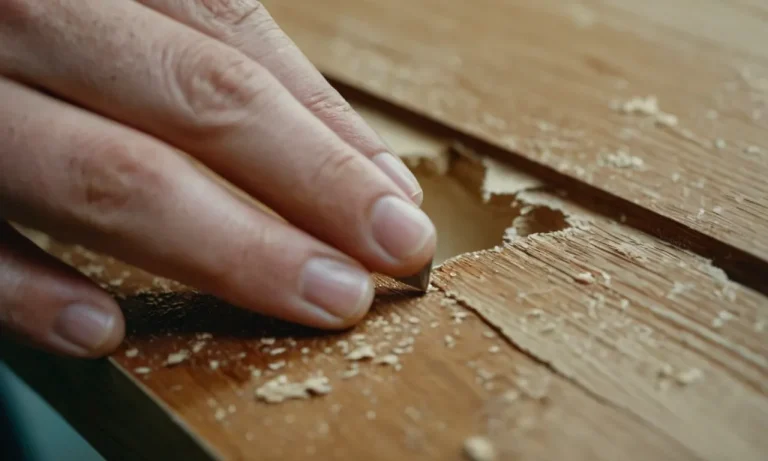Is Acrylic Paint Safe For Babies?
Acrylic paint is a popular choice for artists of all ages due to its versatility, fast-drying qualities, and water-soluble nature. However, when it comes to using acrylic paint around babies and young children, many parents have concerns about its safety.
If you’re short on time, here’s a quick answer to your question: acrylic paint is generally considered safe for babies and kids if used properly. Certain precautions should be taken to avoid potential health hazards.
In this comprehensive guide, we’ll take an in-depth look at acrylic paint ingredients, toxicity levels, safety tips, and recommended nontoxic acrylic paint brands for babies and toddlers. We’ll also examine safe ways for babies and young kids to enjoy acrylic painting without risk.
Background on Acrylic Paints
Acrylic paints have gained popularity among artists and crafters due to their versatility and vibrant colors. They are a type of water-based paint that contains pigment suspended in an acrylic polymer emulsion.
These paints dry quickly and create a durable and flexible finish on various surfaces such as canvas, wood, and paper.
What Are Acrylic Paints Made Of?
Acrylic paints are made up of pigments, binders, and solvents. Pigments are finely ground particles that give the paint its color. Binders are substances that hold the pigments together and adhere them to the painting surface.
In the case of acrylic paints, the binders are acrylic polymers, which are synthetic resins that provide the paint with its adhesive properties. Solvents are used to thin the paint and help with its application.
In acrylic paints, water is commonly used as the solvent, making them water-based and non-toxic.
Unlike oil paints, which require turpentine or mineral spirits as solvents, acrylic paints can be easily cleaned up with water. This makes them a convenient option for artists of all levels, including parents who want to engage their children in creative activities.
Are Acrylic Paints Toxic?
Acrylic paints are generally considered safe and non-toxic when used as directed. The pigments used in these paints are usually made from organic or inorganic compounds that have been deemed safe for use in art materials.
However, it is important to note that some pigments may contain trace amounts of heavy metals, which could be potentially harmful if ingested or inhaled in large quantities.
To ensure the safety of children using acrylic paints, it is recommended to choose paints that are labeled as non-toxic and safe for use by children. These paints have undergone rigorous testing to meet specific safety standards.
Additionally, it is advisable to supervise young children while they are using acrylic paints and encourage them not to put their hands or brushes in their mouths.
If you have concerns about the safety of acrylic paints, you can consult the Material Safety Data Sheets (MSDS) provided by the manufacturers. These sheets provide detailed information about the potential hazards and safety precautions associated with the product.
Is Acrylic Paint Safe for Babies and Toddlers?
As a parent, it is natural to be concerned about the materials and substances your little ones come into contact with. When it comes to artistic activities, such as painting, it is important to ensure that the materials used are safe for babies and toddlers.
Acrylic paint is a popular choice due to its vibrant colors and versatility, but is it safe for our little artists?
Potential Health Risks
Acrylic paint is generally considered safe for use in artistic activities, including those involving babies and toddlers. However, it is important to be aware of potential health risks associated with the use of acrylic paint.
One of the main concerns is the presence of toxic chemicals, such as heavy metals, in some acrylic paint brands. These chemicals can be harmful if ingested or if they come into contact with the skin for prolonged periods.
According to the U.S. Environmental Protection Agency (EPA), some acrylic paints may contain hazardous substances like lead, cadmium, and chromium. These substances can pose a risk to the health of young children, especially if they accidentally ingest or inhale them.
It is important to choose acrylic paints that are labeled as non-toxic and meet safety standards set by regulatory authorities.
It is worth noting that the risk of exposure to toxic substances in acrylic paint is generally low, especially if the paint is used under adult supervision and proper safety precautions are followed.
Recommended Safety Precautions
To ensure the safe use of acrylic paint with babies and toddlers, here are some recommended safety precautions:
- Choose non-toxic acrylic paints: Look for paints that are specifically labeled as non-toxic, meaning they do not contain harmful chemicals. These paints are generally safe for babies and toddlers to use.
- Supervise and limit exposure: Always supervise young children while they are using acrylic paint. Limit their exposure by ensuring they do not ingest the paint or put their hands in their mouths while painting.
- Provide proper ventilation: Ensure that the painting area is well-ventilated to minimize the inhalation of paint fumes. Open windows or use fans to improve air circulation.
- Protect the skin: Encourage children to wear smocks or aprons to protect their clothing and cover any cuts or open wounds with bandages to prevent direct contact with the paint.
- Wash hands thoroughly: After painting, make sure to wash your child’s hands and any other body parts that came into contact with the paint. Use mild soap and water to remove any traces of paint.
By following these safety precautions, you can ensure a safe and enjoyable painting experience for your little ones. Remember, it is always better to err on the side of caution when it comes to the health and well-being of your children.
For more information about the safety of acrylic paint, you can visit the Consumer Product Safety Commission website or consult with your child’s pediatrician.
Choosing the Best Nontoxic Acrylic Paints
When it comes to choosing acrylic paints for babies, safety is of utmost importance. Fortunately, there are several nontoxic options available in the market that are specifically designed to be safe for babies and toddlers.
These paints are made with ingredients that are non-hazardous and free from harmful chemicals, making them a great choice for little ones to explore their creativity.
What Makes an Acrylic Paint Nontoxic?
An acrylic paint is considered nontoxic when it does not contain any harmful substances that can be harmful to babies or young children. Typically, nontoxic acrylic paints are made with natural or organic pigments and do not contain heavy metals or toxic solvents.
They are also water-based, making them easy to clean up and less likely to cause skin irritation.
When purchasing nontoxic acrylic paints, look for labels that indicate they are certified nontoxic or safe for children. This ensures that the paint has undergone rigorous testing to meet safety standards.
Top Nontoxic Brands for Babies and Toddlers
There are several reputable brands that offer nontoxic acrylic paints specifically formulated for babies and toddlers. Here are a few top choices:
- Crayola My First Fingerpaint Kit: This kit includes nontoxic finger paints that are safe for babies to explore with their hands. The paints are easy to wash off and come in vibrant colors that will keep your little one engaged.
- Colorations Simply Washable Tempera Paint: This paint is not only nontoxic but also washable, making it perfect for messy art sessions with babies and toddlers. It comes in a variety of colors and has a smooth consistency that is easy for little hands to work with.
- Apple Barrel Acrylic Paint Set: This set of acrylic paints is widely recommended for its nontoxic formula and vibrant color range. It is suitable for both children and adults, making it a versatile option for family art projects.
Remember, it’s always important to supervise babies and toddlers while they are using acrylic paints to ensure they don’t ingest or come into contact with the paint in a way that may be harmful. With the right nontoxic acrylic paints, you can provide a safe and enjoyable artistic experience for your little ones.
Safe Ways for Babies to Enjoy Acrylic Painting
Supervised Finger Painting
Finger painting is a great way for babies to explore their creativity and engage their senses. However, when it comes to acrylic paint, it’s important to ensure that babies are supervised at all times.
Acrylic paints contain chemicals that may not be safe if ingested or if they come into contact with delicate baby skin. While acrylic paints are generally non-toxic, it’s always better to err on the side of caution.
When supervising finger painting sessions with babies, it’s important to use non-toxic and washable acrylic paints specifically designed for children. These paints are formulated to be safe for little ones and are easily washable from skin and clothes.
It’s also a good idea to cover the painting area with a plastic sheet or newspaper to protect surfaces from any accidental spills or splatters.
Remember, the key is to make sure that your baby has a fun and safe painting experience, so keep a close eye on them and be ready to intervene if necessary.
Using Alternative ‘Paint’ Materials
If you’re concerned about using acrylic paint with your baby, there are alternative materials that can be used for painting activities. One option is to use homemade edible paints made from safe ingredients like yogurt or mashed fruits and vegetables.
These paints are completely safe for babies to use and can be a fun way to introduce them to the world of art.
Another alternative is to use non-toxic, water-based paints specifically made for babies and toddlers. These paints are designed to be safe for little ones and are easy to clean up. They come in a variety of colors and can be used on paper, cardboard, or even easels.
By exploring these alternative materials, you can ensure that your baby can still enjoy the creative process of painting while keeping their safety in mind.
Washable Watercolor Options
Watercolors are another great option for babies to explore their artistic side. Unlike acrylic paints, watercolors are generally non-toxic and can be easily washed off. They come in pans or tubes and can be used with brushes or even with fingers.
When choosing watercolors for your baby, opt for washable and non-toxic varieties specifically made for children. These paints are formulated to be safe and easy to clean up. It’s important to note that even though watercolors are generally safe, it’s still recommended to supervise your baby during painting sessions to prevent any accidental ingestion or contact with sensitive areas like eyes.
Remember, the focus should be on providing a safe and enjoyable painting experience for your baby. By using washable watercolors and supervising their painting activities, you can encourage their creativity while keeping their well-being a top priority.
Conclusion
In summary, acrylic paint can be safely used around babies when proper precautions are taken. Avoid toxic pigments, provide close supervision, and choose specially formulated nontoxic acrylics for little hands.
With sensible precautions in place, parents can feel at ease letting their little ones explore the creative joy of painting with acrylics.







